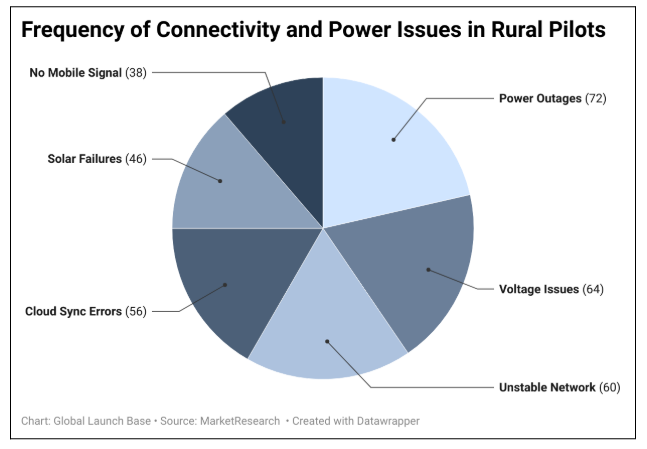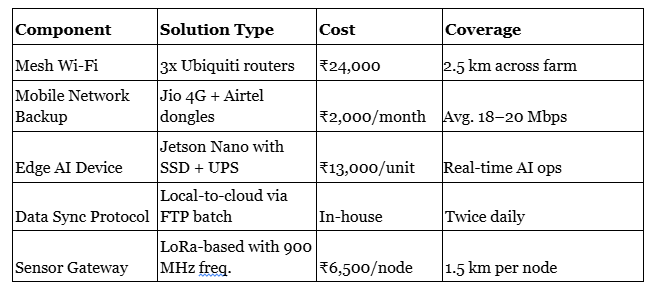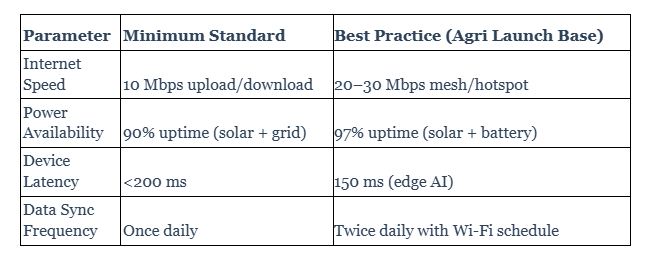Overcoming Rural Connectivity & Power Constraints for High‑Tech Pilots
- Mamta Devi
- Jul 28
- 4 min read

Written By Jagriti Shahi
Introduction
As agriculture integrates with AI, IoT, and data-driven decision-making, the biggest roadblock in rural areas remains infrastructure—particularly internet connectivity and electricity. High-tech pilots often fail not because the tech is flawed but because they assume urban-level infrastructure in remote settings.
In several semi-remote agricultural regions, persistent power supply issues continue to pose significant barriers to scalable technology adoption. During peak summer months, some areas experience prolonged daytime outages—precisely when irrigation needs are most urgent. Compounding the issue are voltage fluctuations and outdated transformers placed in sensitive zones, leading to disruptions even during mild weather. These interruptions render systems like pumps, fertigation units, and cold storage inoperable, slowing or halting otherwise promising agri-tech trials.

Persistent Power Challenges Hindering Agri-Tech Adoption in Karnataka's Heartland
In parts of rural Karnataka, farmers continue to face critical energy infrastructure gaps that severely affect agricultural productivity and technological advancement. During peak summer months, power outages often stretch between 10 to 12 hours during the day—precisely when irrigation is most essential. Compounding this, transformers are frequently located in flood-prone areas near water bodies, leading to frequent disruptions even under mild weather conditions.
Many villages are served only by single-phase lines, which are inadequate for operating essential farm infrastructure such as electric pump sets, fertigation units, cold storage systems, and automation tools. As a result, voltage fluctuations and intermittent supply are common, crippling modern farming operations.
These challenges affect over 300 acres of active farmland, where crops like rice, wheat, vegetables, and fruit orchards are cultivated. With nearly 70% of farmers depending on electric-powered irrigation systems, inconsistent power supply translates to reduced yields, post-harvest losses, and lower farm incomes. It also slows down the transition to sustainable and tech-driven agriculture.
There is an urgent need for infrastructure audits, dedicated 3-phase daytime power schedules, and support for resilient alternatives like solar-grid hybrid systems or rural microgrids. Addressing these structural bottlenecks could unlock a scalable model for resilient, energy-secure farming in Karnataka and beyond.


1. Current Rural Gaps in Connectivity & Power (India 2025)
Only 37% of rural households in India have regular access to 4G internet (TRAI, Q1 2025).
Average rural internet speed: 12.7 Mbps (vs. 52.1 Mbps urban).
Power outages in rural Karnataka: ~3.6 hours/day average (Ministry of Power, 2025).
Only 26% of farms have any form of solar backup or diesel generator.
These numbers underscore the urgent need for localized, resilient infrastructure for deploying agri-tech pilots.
2. Agri Launch Base: Rural Tech Setup Blueprint
Our Agri Launch Base is a 2.07 ha experimental farm located in Shivamogga district, Karnataka. The site is used for real-world testing of climate-smart farming tools, AI-powered sensors, and drone imaging for pepper and mango orchards.
Energy Infrastructure:
1. Current Rural Gaps in Connectivity & Power (India 2025)
Only 37% of rural households in India have regular access to 4G internet (TRAI, Q1 2025).
Average rural internet speed: 12.7 Mbps (vs. 52.1 Mbps urban).
Power outages in rural Karnataka: ~3.6 hours/day average (Ministry of Power, 2025).
Only 26% of farms have any form of solar backup or diesel generator.
These numbers underscore the urgent need for localized, resilient infrastructure for deploying agri-tech pilots.
2. Agri Launch Base: Rural Tech Setup Blueprint
Our Agri Launch Base is a 2.07 ha experimental farm located in Shivamogga district, Karnataka. The site is used for real-world testing of climate-smart farming tools, AI-powered sensors, and drone imaging for pepper and mango orchards.
Energy Infrastructure:

Internet Infrastructure:

3. Proven Tech Solutions to Bridge Rural Gaps

A. Solar Energy + Smart Batteries
Use Li-ion or LFP batteries for farms with low daily loads (IoT sensors, cameras).
Add IoT-enabled MPPT charge controllers to manage solar input with cloud control.
“Installing a 5 kW solar system with a 10 kWh battery saves ₹4,800/month in diesel costs.”
B. Mesh Networking
Mesh routers automatically relay signals through each other—ideal for hilly/forested farms.
Combine with directional antennas for longer coverage (up to 5 km per hop).
Example: The Agri Launch Base mesh network covers 2.5 km with just 3 nodes.
C. Edge Computing
Reduces internet load by processing data locally.
Example: AI pest identification runs on-site using Jetson Nano, syncing to the cloud only once/day.
“Edge AI cut data usage by 88% during our April 2025 pepper pest analysis pilot.”
Recommended Benchmarks for High-Tech Pilots

Scaling Blueprint for Rural Tech Pilots
Minimum Setup (Entry-level Agri-Tech Pilot):
Solar: 3 kW + 5 kWh battery → ₹1.6 lakh
Mesh: 2 routers + 1 LTE dongle → ₹20,000
Edge AI: 1 Jetson Nano unit → ₹13,000
LoRa Sensors: 5–10 nodes → ₹40,000–50,000
Total Cost (1-acre test farm): ₹2.5–2.9 lakhs
Scalable Model (10–20 acre clusters):
Community solar mini-grid + shared server node
Youth-trained mesh maintainers (₹5,000/month stipend)
Plug-and-play kits for sensors with QR-based install
5. Practical Tips to Build Rural Tech Confidence
Involve local youth as digital stewards—train them on mesh network resets and solar diagnostics.
Pilot test energy loads before deploying full systems.
Design offline modes for all software: Ensure agri apps can store data offline and sync later.
Maintain dual backups—both energy (solar + diesel) and internet (mesh + mobile).
Conclusion
To build global-local trust in rural tech pilots, infrastructure must be resilient, affordable, and community-supported. The Agri Launch Base model shows how combining solar, mesh networks, and edge computing enables even small rural farms to host AI-driven pilots with confidence.





Comments